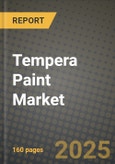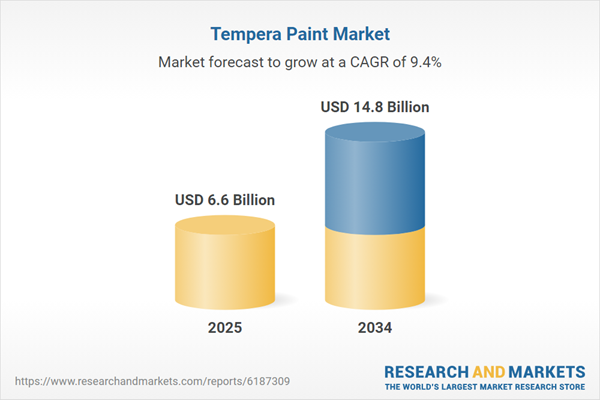The Tempera Paint Market is a niche but enduring segment within the global art supplies and educational materials industry, recognized for its affordability, safety, and versatility. Tempera paint - often egg-based or formulated with non-toxic synthetic binders - is widely used in educational institutions, children's crafts, and professional art restoration projects. Unlike oil paints, tempera dries quickly to a matte finish and can be easily cleaned with water, making it ideal for classrooms, home art studios, and community centers. The market spans tempera paint in various forms, including ready-mixed liquid bottles, powder pigments, and cake palettes, serving the needs of both casual hobbyists and art professionals. Key manufacturers such as Crayola, Sargent Art, Prang, and Colorations continue to offer a broad spectrum of tempera products, including washable, fluorescent, and metallic variants. With growing interest in art therapy, DIY projects, and early childhood creativity, tempera paint remains a go-to medium for safe, expressive, and cost-effective artistic exploration.
The tempera paint market experienced steady demand, particularly driven by the resurgence of hands-on learning in K-12 education and the continued rise of at-home creative activities. Educational institutions re-emphasized arts programs post-pandemic, leading to bulk procurement of tempera paints due to their ease of use and classroom-friendly properties. Online retailers and educational distributors reported increased sales of eco-friendly and non-toxic tempera paints, reflecting parental and institutional preferences for safe materials. Additionally, brands diversified their product lines with washable and quick-dry options, addressing the needs of teachers and caregivers managing group art sessions. Social media and short-form video platforms played a key role in driving interest in tempera-based DIY content, including seasonal crafts and art challenge videos. Artists and educators also began favoring multipurpose tempera mediums for mural projects, stage set painting, and poster-making. In response, manufacturers introduced refill packs, bundle kits, and recyclable packaging options to reduce cost and environmental impact while catering to bulk buyers and sustainability-conscious consumers alike.
The tempera paint market is expected to evolve through product innovation, digital engagement, and expanded applications beyond traditional educational use. Brands are likely to focus on sensory-enhanced tempera variants - such as scented, textured, and glow-in-the-dark formulas - to captivate children’s attention and encourage multi-sensory learning. The integration of augmented reality (AR) features with painting kits may emerge, allowing young users to animate their artwork through mobile applications. Demand is also anticipated to grow in Therapeutic and eldercare sectors, where tempera’s simplicity and vibrant colors offer valuable tools for art therapy and cognitive stimulation. Emerging markets, especially in Southeast Asia and Latin America, will present new opportunities as governments and NGOs invest in creative learning initiatives and low-cost educational supplies. At the same time, the industry will need to manage supply chain efficiency and pricing strategies, especially as raw material costs and environmental compliance standards evolve. The future of tempera paint will hinge on its ability to remain safe, affordable, and creatively enriching across generations and global markets.
Key Insights: Tempera Paint Market
- Eco-friendly and non-toxic formulations are becoming standard, with schools and parents prioritizing safety and sustainability in art supplies for young children.
- Washable and quick-drying tempera paints are gaining popularity for classroom and home use, reducing mess and clean-up time during group projects.
- Innovative sensory paint options - such as glitter, metallic, scented, and textured tempera - are expanding creative possibilities in early childhood education and therapy.
- Online art kits bundled with tempera paints are trending, supported by influencer-driven craft tutorials and virtual art classes on platforms like YouTube and TikTok.
- Recyclable packaging and refill options are being introduced to address rising demand for sustainable and cost-effective bulk purchasing in schools and studios.
- Increased investment in early childhood and arts education is driving demand for classroom-safe, affordable paints that support motor skill development and creativity.
- Growth in at-home crafts and DIY activities, particularly among families and hobbyists, is sustaining retail demand for tempera paint in multi-pack formats.
- Expanding use of tempera in therapeutic settings and special education programs is positioning the medium as a key tool for emotional expression and sensory engagement.
- Product diversification into themed paint sets and art kits is helping brands attract new consumers through gifting, seasonal projects, and subscription models.
- One major challenge is maintaining profitability amid rising raw material and packaging costs while keeping prices affordable for schools and budget-conscious consumers, particularly in highly price-sensitive regions and public procurement contracts.
Tempera Paint Market Segmentation
By Product Type
- Traditional Tempera Paint
- Modern Tempera Paint
By Color Variation
- Basic Colors
- Assorted Colors
By Price Range
- Economy Range
- Mid-Range
- Professional Grade
By Application
- Artwork
- Decorate
- Other Applications
By End User
- Schools and Educational Institutions
- Professional Artists
- Hobbyists and DIY Enthusiasts
Key Companies Analysed
- F.I.L.A. Group (Daler-Rowney, Canson, and Lyra)
- Crayola LLC
- Sargent Art, Inc.
- Blick Art Materials, LLC
- Faber-Castell AG
- Prang (Dixon Ticonderoga Company)
- Sakura Color Products Corporation
- Reeves Art
- Royal & Langnickel Brush Manufacturing, Inc.
- Colart Group (Liquitex, Winsor & Newton)
Tempera Paint Market Analytics
The report employs rigorous tools, including Porter’s Five Forces, value chain mapping, and scenario-based modeling, to assess supply-demand dynamics. Cross-sector influences from parent, derived, and substitute markets are evaluated to identify risks and opportunities. Trade and pricing analytics provide an up-to-date view of international flows, including leading exporters, importers, and regional price trends.Macroeconomic indicators, policy frameworks such as carbon pricing and energy security strategies, and evolving consumer behavior are considered in forecasting scenarios. Recent deal flows, partnerships, and technology innovations are incorporated to assess their impact on future market performance.
Tempera Paint Market Competitive Intelligence
The competitive landscape is mapped through proprietary frameworks, profiling leading companies with details on business models, product portfolios, financial performance, and strategic initiatives. Key developments such as mergers & acquisitions, technology collaborations, investment inflows, and regional expansions are analyzed for their competitive impact. The report also identifies emerging players and innovative startups contributing to market disruption.Regional insights highlight the most promising investment destinations, regulatory landscapes, and evolving partnerships across energy and industrial corridors.
Countries Covered
- North America - Tempera Paint market data and outlook to 2034
- United States
- Canada
- Mexico
- Europe - Tempera Paint market data and outlook to 2034
- Germany
- United Kingdom
- France
- Italy
- Spain
- BeNeLux
- Russia
- Sweden
- Asia-Pacific - Tempera Paint market data and outlook to 2034
- China
- Japan
- India
- South Korea
- Australia
- Indonesia
- Malaysia
- Vietnam
- Middle East and Africa - Tempera Paint market data and outlook to 2034
- Saudi Arabia
- South Africa
- Iran
- UAE
- Egypt
- South and Central America - Tempera Paint market data and outlook to 2034
- Brazil
- Argentina
- Chile
- Peru
Research Methodology
This study combines primary inputs from industry experts across the Tempera Paint value chain with secondary data from associations, government publications, trade databases, and company disclosures. Proprietary modeling techniques, including data triangulation, statistical correlation, and scenario planning, are applied to deliver reliable market sizing and forecasting.Key Questions Addressed
- What is the current and forecast market size of the Tempera Paint industry at global, regional, and country levels?
- Which types, applications, and technologies present the highest growth potential?
- How are supply chains adapting to geopolitical and economic shocks?
- What role do policy frameworks, trade flows, and sustainability targets play in shaping demand?
- Who are the leading players, and how are their strategies evolving in the face of global uncertainty?
- Which regional “hotspots” and customer segments will outpace the market, and what go-to-market and partnership models best support entry and expansion?
- Where are the most investable opportunities - across technology roadmaps, sustainability-linked innovation, and M&A - and what is the best segment to invest over the next 3-5 years?
Your Key Takeaways from the Tempera Paint Market Report
- Global Tempera Paint market size and growth projections (CAGR), 2024-2034
- Impact of Russia-Ukraine, Israel-Palestine, and Hamas conflicts on Tempera Paint trade, costs, and supply chains
- Tempera Paint market size, share, and outlook across 5 regions and 27 countries, 2023-2034
- Tempera Paint market size, CAGR, and market share of key products, applications, and end-user verticals, 2023-2034
- Short- and long-term Tempera Paint market trends, drivers, restraints, and opportunities
- Porter’s Five Forces analysis, technological developments, and Tempera Paint supply chain analysis
- Tempera Paint trade analysis, Tempera Paint market price analysis, and Tempera Paint supply/demand dynamics
- Profiles of 5 leading companies - overview, key strategies, financials, and products
- Latest Tempera Paint market news and developments
Additional Support
With the purchase of this report, you will receive:- An updated PDF report and an MS Excel data workbook containing all market tables and figures for easy analysis.
- 7-day post-sale analyst support for clarifications and in-scope supplementary data, ensuring the deliverable aligns precisely with your requirements.
- Complimentary report update to incorporate the latest available data and the impact of recent market developments.
This product will be delivered within 1-3 business days.
Table of Contents
Companies Mentioned
- F.I.L.A. Group (Daler-Rowney Canson
- and Lyra)
- Crayola LLC
- Sargent Art Inc.
- Blick Art Materials LLC
- Faber-Castell AG
- Prang (Dixon Ticonderoga Company)
- Sakura Color Products Corporation
- Reeves Art
- Royal & Langnickel Brush Manufacturing Inc.
- Colart Group (Liquitex Winsor & Newton)
Table Information
| Report Attribute | Details |
|---|---|
| No. of Pages | 160 |
| Published | October 2025 |
| Forecast Period | 2025 - 2034 |
| Estimated Market Value ( USD | $ 6.6 Billion |
| Forecasted Market Value ( USD | $ 14.8 Billion |
| Compound Annual Growth Rate | 9.3% |
| Regions Covered | Global |
| No. of Companies Mentioned | 11 |









